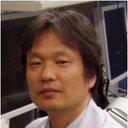Roles of epidermal growth factor and Na+/H+ exchanger-1 in esophageal epithelial defense against acid-induced injury.
Ključne riječi
Sažetak
Epidermal growth factor (EGF) is predominantly secreted by salivary glands and activates Na(+)/H(+) exchanger-1 (NHE-1), which regulates intracellular pH (pH(i)). We investigated the roles of EGF and NHE-1 in esophageal epithelial defense against acid using human esophageal epithelial cell lines and a rat chronic esophagitis model. Esophageal epithelial cells were incubated with acidified medium in the absence or presence of EGF. Cell viability and changes in pH(i) were measured. Chronic acid reflux esophagitis was induced in rats with and without sialoadenectomy. Esophageal lesion index, epithelial proliferation, and expression of EGF receptors and NHE-1 were examined. EGF protected esophageal epithelial cells against acid in a dose-dependent manner, and the cytoprotective effect of EGF was completely blocked by treatment with NHE-1 inhibitors. Tyrosine kinase, calmodulin, and PKC inhibitors significantly inhibited cytoprotection by EGF, whereas MEK, phosphatidylinositol 3-kinase, and PKA inhibitors had no effect. EGF significantly increased pH(i) recovery after NH(4)Cl pulse acidification, and this increase in pH(i) recovery was significantly blocked by inhibitors of calmodulin and PKC. Sialoadenectomy led to an increase in the severity of chronic esophagitis but affected neither epithelial proliferation nor expression of EGF receptors. Expression of NHE-1 mRNA was increased in esophagitis and upregulated in rats with sialoadenectomy. The increasing severity of esophagitis in rats with sialoadenectomy was prevented by exogenous administration of EGF. In conclusion, EGF protects esophageal epithelial cells against acid through NHE activation via Ca(2+)/calmodulin and the PKC pathway. Deficiency in endogenous EGF is associated with increased severity of esophagitis. EGF and NHE-1 play crucial roles in esophageal epithelial defense against acid.


